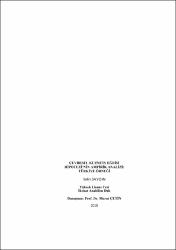| dc.contributor.author | Saygın, Selin | |
| dc.date.accessioned | 2019-12-27T08:10:25Z | |
| dc.date.available | 2019-12-27T08:10:25Z | |
| dc.date.issued | 2018 | |
| dc.identifier.uri | https://hdl.handle.net/20.500.11776/3335 | |
| dc.description.abstract | Bu tez çalışmasının temel amacı, ekonomik büyüme ve çevre kirliliği arasındaki ilişkiyi ters-U şeklinde açıklayan Çevresel Kuznets Eğrisi hipotezinin geçerliliğini Türkiye ekonomisinde 1960-2014 dönemi itibariyle araştırmaktır. Bu amaçla karbondioksit emisyonu, kişi başına reel gelir, kişi başına reel gelirin karesi, enerji tüketimi ve ticari dışa açıklık değişkenleri kullanılarak 3 farklı regresyon modeli oluşturulmuştur. Çalışmada değişkenlerin durağanlık derecelerinin tespiti için ADF, PP ve KPSS birim kök testleri kullanılmıştır. Birim kök test sonuçları, değişkenler arasındaki uzun dönem ilişkisinin tespiti için ARDL sınır testinin kullanılmasına izin vermektedir. Bu nedenle çalışmada değişkenler arasındaki eşbütünleşme ilişkisinin incelenmesinde ARDL snır testi kullanılmıştır. Son aşamada ise ARDL modeli çerçevesinde değişkenlerin uzun ve kısa dönem katsayıları tahmin edimiştir. Elde edilen sonuçlar, üç modelde de Çevresel Kuznets Eğrisi hipotezinin Türkiye ekonomisi için geçerliliğini destekler yöndedir. Sonuçlar aynı zamanda Türkiye ekonomisi için önemli politika önerileri sunabilmektedir | en_US |
| dc.description.abstract | The main objective of this thesis is to investigate the validity of the Environmental Kuznets Curve (EKC) hypothesis which explain the presence of inverted-U shaped relationship between economic growth and environmental pollution for the period of 1960-2014 in Turkish economy. For this purpose, three different regression models were developed by using carbon dioxide emissions, per capita real income, the square of per capita real income, energy consumption and trade openness. In the study, ADF, PP and KPSS unit root tests were used to determine the stationarity properties of the variables. The unit root test results allow the use of the ARDL bounds test to determine the long term relationship between the variables. For this reason, the ARDL bounds test was used to examine the cointegration relationship between variables in the study. In the last stage, the long and short term coefficients of variables were estimated in the context of ARDL model. The obtained results support the validity of the EKC hypothesis for Turkey's economy hypothesis in three models. The results also can provide important policy implications for Turkey's economy. | en_US |
| dc.language.iso | tur | en_US |
| dc.publisher | Namık Kemal Üniversitesi | en_US |
| dc.rights | info:eu-repo/semantics/openAccess | en_US |
| dc.subject | Karbondioksit Emisyonu | en_US |
| dc.subject | Ekonomik Büyüme | en_US |
| dc.subject | Çevresel Kuznets Eğrisi | en_US |
| dc.subject | ARDL Sınır Testi | en_US |
| dc.subject | Türkiye | en_US |
| dc.subject | Carbondioxide Emissions | en_US |
| dc.subject | Economic Growth | en_US |
| dc.subject | Environmental Kuznets Curve | en_US |
| dc.subject | ARDL Bounds Test | en_US |
| dc.subject | Turkey | en_US |
| dc.title | Çevresel kuznets eğrisi hipotezi’ nin ampirik analizi: Türkiye örneği | en_US |
| dc.type | masterThesis | en_US |
| dc.department | Enstitüler, Sosyal Bilimler Enstitüsü, İktisat Ana Bilim Dalı | en_US |
| dc.relation.publicationcategory | Tez | en_US |



















